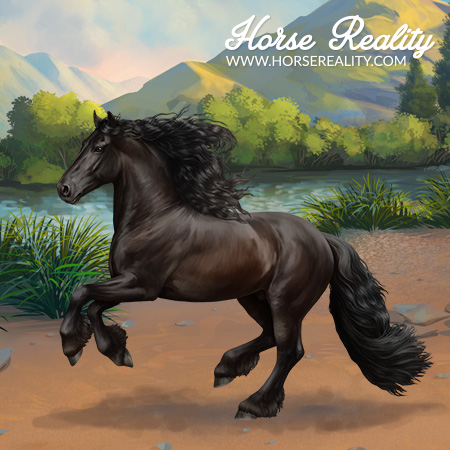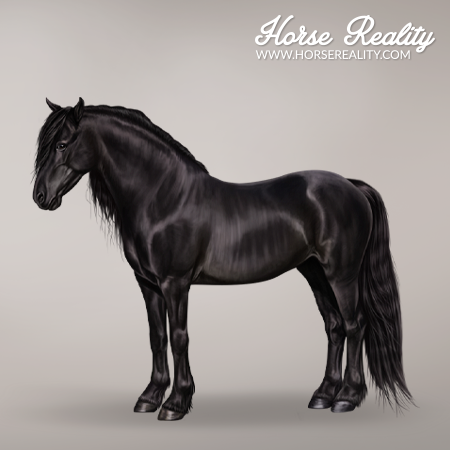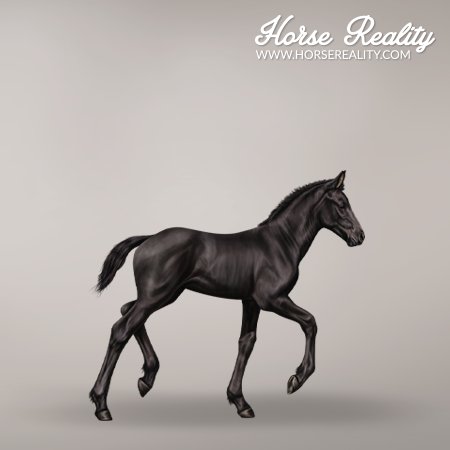The Friesian Horse is a breed available in the Horse Reality game that can be obtained from the Foundation.
| Friesian Horse | |
|---|---|

|
|
| General Information | |
| Alternative names | Friesian, Frisian, Fries |
| Origin | Friesland (Netherlands) |
| Horse Reality | |
| Colours | Black, Chestnut, Flaxen, Sooty |
| Whites | White Markings |
| Not yet in-game | - |
| Height | 153 - 173 cm |
| Registry | Friesian Horse Society |
| Origin | Foundation |
| Status | In-game (2018) |
| Artists | |
| Lineart | D. Grochowska (2021) |
| Greyscale | D. Grochowska (2021) |
| Colours & patterns | D. Grochowska (2021, 2023) |
¶ Conformation
The Friesian Horse is one of the best-known breeds around the world. Their popularity is mostly caused by their majestic, baroque look. They have noble heads with small ears and large, expressive eyes. Long, wavy manes curtain elegant and upright necks set on well-proportioned bodies. Feathered legs are very muscular and quite heavily feathered which creates a magnificent view in their high-stepping gaits[1].
¶ Colour Genetics
Though the Friesian once came in all base colours, black has been the preferred choice for many generations, resulting in the breed's well-known black phenotype. Only rarely foals are born with the chestnut colour, as the recessive red allele is still hidden in the population. When two rare heterozygous parents are bred together, there is a 25% chance of a chestnut-coloured foal. Using DNA testing, most chestnut carriers have been identified in the population, and breeders may choose to select against it.
White markings are rare. They pop up from time to time, though far more often than chestnut base colour. Most markings are as small as a few white hairs or a small star on a horse's head. More white is not allowed and therefore excluded.
¶ Alleles
All alleles available for the breed can be found below highlighted in green. For better clarity, we bolded alleles that impact coat colours (eg. grey G vs non-grey g).
| Base Colours & Modifiers | ||
|---|---|---|
| Extension | Agouti | Grey |
| E, e | a | g |
| Dilutions | ||||
|---|---|---|---|---|
| Cream-Pearl | Dun | Champagne | Silver | Mushroom |
| n | nd2 | ch | z | n |
| White Patterns | |||||
|---|---|---|---|---|---|
| Frame | Appaloosa | PATN1 | MITF | SW2 | KIT |
| n | lp | patn1 | n | sw2 | n |
Please note that besides testable genes, there are also untestable ones present: flaxen, sooty, and white markings (head markings, socks, etc.).
¶ Artwork Updates
The Friesian Horse was one of the first breeds designed for the game, all the way back in the alpha version in 2013. Ever since the current Horse Reality version has been online, the Friesian received/will receive the following updates:
- On September 8th 2021, the Friesian Horse received new artwork[2]
- On April 19th 2023, the sooty allele was added to the game through new Foundation horses[3]
- On March 26th 2025, the Friesian horse was migrated to the new art system[4][5]
As of now, the breed has a complete set of alleles[6]
¶ Artwork Legacy
If you're curious about what the Friesian Horse looked like before the artwork update or just want to reminisce good, old times - search no more.

|

|

|
Very talented artists created this beautiful art. Horse Reality is forever grateful for them being a part of its history.
| Artists | |
|---|---|
| Lineart | A. Debets (2012) |
| Greyscale | M. Simon (2013) |
| Colours & patterns | T. van den Berg (2013) |
¶ Breed in Real Life
The Friesian is an old and majestic horse breed originating from the province of Friesland in the Netherlands, but swiftly rising in popularity in the rest of Europe and indeed, all over the world. They have been selectively bred for colour, type and movement for many centuries, resulting in a unique horse that is often used in crossbreeding.
These baroque horses elicit a sense of pride due to their stature and long, flowing hair, making them very popular horses for dressage, carriage driving and movie productions. As with many breeds, modern demands have caused a shift in breeding purposes, resulting in a new, more luxurious type that performs better in international competitions, though often at the cost of the original baroque version.
The Friesian's unique conformation is also its greatest weakness: to maintain the unique characteristics, breeders often used inbreeding to confirm the horses' features. While there are presently many Friesians all over the world, all are descended from a small number of stallions, putting the breed at risk with disorders like dwarfism and hydrocephalus. By advising breeders, monitoring inbreeding coefficients and using DNA tests to identify carriers of unwanted disorders in the population, the registry is making a strong effort to improve the breed's health[1].
¶ References
- T. Pickeral, The Majesty of the Horse: An Illustrated History, HarperCollins Publishers Limited, 2012
- https://v2.horsereality.com/news/71/community-update-fixed-competition-calculations-updated-team-roles-friesian-art-redo-brabant-coat-variations-merge-info-page
- https://v2.horsereality.com/news/133/community-update-foundation-batch-1-pantaneiro-horse-release-date-poll-results-more
- https://v2.horsereality.com/news/216/release-notes-the-1st-migration-batch-cookie-banner-text-adjustments-more
- https://v2.horsereality.com/news/215/announcement-the-1st-migration-batch-arrives-march-26
- https://deloryan.notion.site/Horse-Breeds-Artwork-Genetics-6d0a84be35284b12806976bbb8cc886c